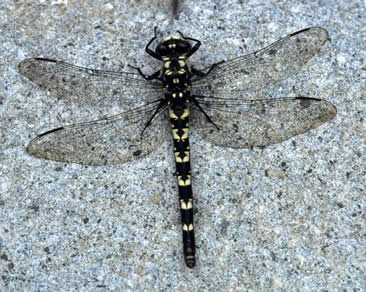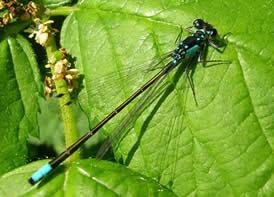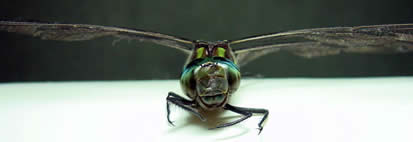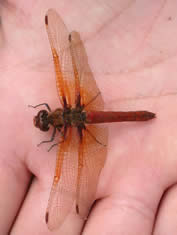

THE DRAGONFLIES (ODONATA) OF BRITISH COLUMBIA

Black Petaltail (Tanypteryx hageni), photo by Ian Lane
by
R. A. Cannings and G. G. E. Scudder
Copyright © 2005 - All rights reserved
Visit the atlas pages for the Odonata of BC
Description
Although the insect order Odonata contains both the groups of insects known in English as the dragonflies and damselflies, following common usage we also use the name “dragonflies” to refer to the order as a whole. The Odonata contains about 5000 named species and 23 families world-wide. It is predominantly tropical in distribution and is not as diverse at higher latitudes.
The Odonata and their ancestors are some of the most ancient of insects. They have many primitive features, but also possess many specializations that reflect their aerial and predatory lifestyle. The huge compound eyes and minute, hair-like antennae emphasize their visually oriented behaviour. The order contains two suborders in British Columbia: the Zygoptera (damselflies), the Anisoptera (dragonflies). Damselflies are slimmer, often smaller, and usually fly more slowly than dragonflies. At rest their equal-sized wings are usually held together above the body. Zygoptera means “joined wings”. Dragonflies are robust, often fast-flying, with the hindwings broader than the forewings: when perched they hold their wings out away from the body. Anisoptera means “unequal wings”.

Pacific Forktail (Ischnura cervula), photo by Dave Ingram
There are 10 families, 27 genera and 87 species known in the province. They range in size from the small Ischnura perparva Selys and Nehalennia irene (Hagen) (wingspans as little as 25 mm) to the large Anax junius (Drury) and Cordulegaster dorsalis Hagen (wingspans to 110 mm), which are among the largest of our insects.
Dragonflies are large and abundant insects and, because of this, the order forms one of the predominant groups in standing freshwater communities in British Columbia. In the mountains of western Canada, species are less abundant in running water than they are in standing water habitats, presumably because the former are often cold, originating in mountain snows. Dragonflies live around most types of fresh water. Certain kinds prefer lakeshores, others are found only along streams, or around springs and in peatlands. Ponds and marshes rich in aquatic vegetation support the most species.

Canada Darner (Aeshna canadensis ), photo by Sylvia Letay
Dragonflies have two pairs of long, membranous wings patterned with numerous cross-veins. Although dragonflies cannot fold their wings flat over their backs (an ancestral condition they share with mayflies), unlike most insects they can work their four wings independently. This produces in extremely agile flight, making the insects superb aerial predators. Their prey is a wide range of flying insects, and is usually captured in flight with the dragonfly’s spiny legs. Despite tales to the contrary, dragonflies do not bite or sting people. Adults are often colourfully patterned, and exhibit a wide variety of readily observed behaviour. Mature males patrol the breeding habitats, aggressively searching for mates, and may, like birds, defend a territory against other males of the species. These territories limit aggression and prevent undue disturbance of egg-laying females. Sometimes in crowded situations group territories with dominance hierarchies are established.
When
he is ready to mate, a male grasps a female by the front of the
thorax (damselflies) or by the top of the head (dragonflies)
with the appendages at the tip of the abdomen. The female loops
the end of her abdomen up to the base of the male’s abdomen
where the sperm is stored and transferred via the unique secondary
genitalia. The Odonata are the only insects that mate in this
wheel position.

Cardinal Meadowhawk (Sympetrum illotum), photo by Dave Ingram
The female lays the eggs once they are fertilized. All damselflies and some dragonflies (mainly the Aeshnidae) have a knife-like egg-laying structure called an ovipositor, at the tip of the abdomen. They lay their eggs in plant tissue of various sorts. Competition for mates is usually fierce, and male aggression can prevent females from laying their eggs. Females ovipositing alone are usually secretive. In many species, the male often retains his hold on the female while she lays her eggs, guarding her from other males who may attempt to mate with her. Some damselflies actually crawl below the water surface to escape the attentions of males, remaining there for over an hour to lay their eggs. The large stream-dwelling Cordulegaster has a spike-like ovipositor that drives eggs into the mud and sand of the streambed. Other species lacking ovipositors usually just dip the tip of the abdomen into the water and wash the eggs off, and the eggs sink to the bottom.
The aquatic larvae are predacious and are armed with an enormous hinged labium, sort of a lower lip, which is used as an extendible grasping organ for capturing prey. This type of labium is unique to the Odonata. Larvae are voracious, eating small aquatic insects, crustaceans and even fish. Anisopteran larvae pump water in and out of the rectum, which is lined with gills. This pump is also used as an escape mechanism – if a jet of water is forced out of the rectum, the larva speeds away, jet-propelled. Zygopteran larvae have three leaf-like gills at the tip of the abdomen.
Larvae can be categorized according to their feeding behaviour. Climbers (Zygoptera, Aeshnidae) are streamlined stalkers that live in submerged vegetation. Sprawlers (Macromiidae, Corduliidae and Libellulidae) lie in ambush on the bottom mud and detritus. Burrowers (Gomphidae, Cordulegastridae) cover themselves with sand and mud and await their prey. Larvae moult 10 to 15 times as they grow. When fully grown, the larva crawls out of the water up a plant stalk or some other support. The skin on its back splits open and the adult dragonfly emerges, expands and dries. The empty larval skin (exuvia) remains as a reminder of the larva’s aquatic life.
Damselflies,
and many dragonflies, develop rapidly. For many species in British
Columbia the life cycle takes about a year. Lestes and
some Sympetrum species overwinter as eggs, hatch in
the spring and emerge as adults in the summer. Others overwinter
as larvae and emerge the following spring or summer, although
probably in some species under certain conditions, the larvae
overwinter two years. However, in the larger dragonflies, such
as Aeshna or Somatochlora, the short summers
of high altitudes in the province often mean that four or five
years are spent in the larval stage. Adult dragonflies in British
Columbia live for about one to two months.
References
Cannings, R.A. 2002. Introducing the dragonflies of British Columbia and the Yukon. Royal British Columbia Museum, Victoria and University of British Columbia Press, Vancouver.
Cannings, R.A. and K.M. Stuart. 1977. The dragonflies of British Columbia. British Columbia Provincial Museum Handbook No. 35. Victoria. 254 pp.
Corbet, P.S. 1999. Dragonflies: behavior and ecology of Odonata. Cornell University Press, Ithaca, N.Y. 829 pp.
Needham J.G., M.J. Westfall, Jr., and M.L. May. 2000. Dragonflies of North America. Scientific Publishers, Gainesville. 939 pp.
Walker, E.M. 1953. The Odonata of Canada and Alaska. Volume 1. Univ. Toronto Press, Toronto. 292 pp.
Walker, E.M. 1958. The Odonata of Canada and Alaska. Volume 2. Univ. Toronto Press, Toronto. 318 pp.
Walker, E.M. and P.S. Corbet. 1975. The Odonata of Canada and Alaska. Volume 3. Univ. Toronto Press, Toronto. 307 pp.
Westfall, M.J., Jr. and M.L. May. 1996. Damselflies of North America. Scientific Publishers, Gainesville. 649 pp.
Please cite these pages as:
Author, date, page title. In: Klinkenberg, Brian. (Editor) 2023. E-Fauna BC: Electronic Atlas of the Fauna of British Columbia [www.efauna.bc.ca]. Department of Geography, University of British Columbia, Vancouver. [Date Accessed]
© Copyright 2023 E-Fauna BC.